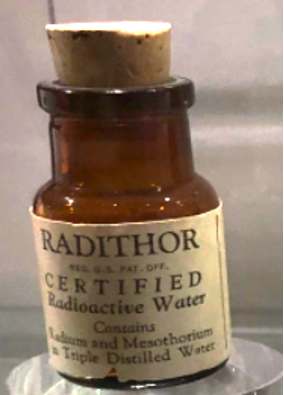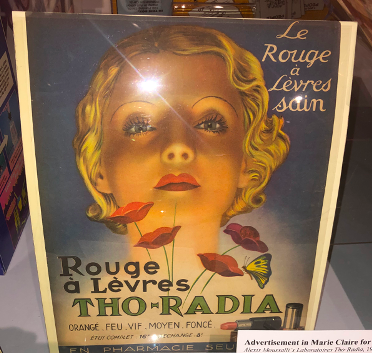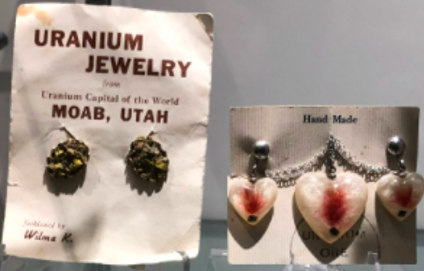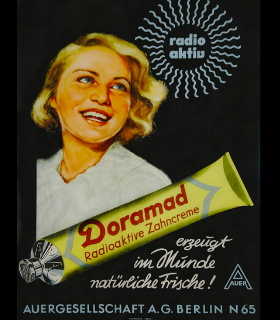Should you happen to be in the vicinity of Albuquerque don't miss the National Museum of Nuclear Science & History. It is fascinating. It's also bewildering to see what people were putting in, and on, their bodies in the 1920s and 30s. The exhibits in this New Mexico museum make today's quackery look like peer-reviewed studies in JAMA. Here are some of them.

Should you happen to be in the vicinity of Albuquerque, NM I recommend that you make a stop at the National Museum of Nuclear Science & History. It is fascinating. Of course, it has exhibits on the Hiroshima and Nagasaki bombs, nuclear accidents, and the new generation of much safer Integral Fast Reactors (See my colleague Dr. Alex Berezow's article on IFRs here.)
But what really piqued my interest was some truly bizzaro medicinal and personal care products that all "worked" because they were radioactive. My, how times have changed (1). There is some crazy s### in there. People gleefully used it back then, but would now flee from the stuff as if being chased by a pre-menstrual saber-tooth tiger, especially these days when people are scared of all chemicals, WiFi, microwave ovens, and 5G, (which, by the way, is not the cause of COVID-19, no matter what the nut logs say.)
Here are just a few (of many) products that were used at the beginning of the 20th century.
The Thomas Radioactive Cone (ca.1912)

This odd-looking object had an even odder use. The Thomas Radioactive Cone consisted of a core of a uranium mineral called carnotite (not visible). Seventy grams of carnotite was encased in a porous concrete cone. Then the thing was put into 1-2 gallons of water, which resulted in the emission of radioactive radon gas. Then people drank the water for its presumed health benefits, which borders on hilarious because people now pay thousands of dollars to have the stuff removed from their basements.
What was it supposed to do? Hard to say.
“neither time nor money” in their “efforts to substantiate . . . the almost unbelievable health results that early users of this invention [the Thomas Radium C. R. Jar] had obtained.”
Source: R. W. Thomas and the Revigator
Radithor Certified Radioactive Water

Why bother with a silly cone when you can just buy the water? Also, perhaps you're not a radon fan. Fortunately, Bailey Radium Laboratories made your life easier and more radioactive. It's also a fine example of bona fide madness.
The water in Radithor was distilled three times. After all, who would want to take the chance that some unknown impurity might be in the water before the company added radium 226 and 228, both of which are radioactive? The company guaranteed a minimum of 1 microcurie per bottle. How healthy was it? Not so much.
The gory quote below shows what happened to Eben McBurney Byers, a millionaire industrialist in the 1920s. Byers suffered an arm injury and sought "medical help" from Charles Clinton Moyar, a physiotherapist in Pittsburgh. Moyar recommended Radithor. Bad move. Byers initially claimed that he "felt great." So great that he drank 1400 bottles of the stuff. After that, he didn't feel so great.
"Young in years and mentally alert, [Byers] could hardly speak. His head was swathed in bandages. He had undergone two successive jaw operations and his whole upper jaw, excepting two front teeth, and most of his lower jaw had been removed. All the remaining bone tissue of his body was slowly disintegrating, and holes were actually forming in his skull."
Source: R. M. Macklis, "Radithor and the era of mild radium therapy," J. Amer. Med. Assoc. 264, 614 (1990)
Byers' death in 1932 marked the end of radioactive "medicines."
Pucker Up!
Radioquackery was not limited to "improved" health. It was also used to improve the way you looked (at least until your jaw fell off). It is difficult to miss the irony in the following. Pharmacist Alexis Mousalli and (irony alert) Dr. Alfred Curie (no relation to Marie) invented a line of radiation-based cosmetics for French women to give them "a healthy glow." (That supernova thing that appears to be coming from her forehead, although amusing, is not real. I had the automatic flash inadvertently set on my iPhone and the glass did the rest.)

The ad above was published in Marie Claire Magazine (ca. 1937). It is promoting Tho-Radia, the "healthy lipstick" (sold in pharmacies only), which came in five colors: Orange, Fire Bright, Medium, and Dark, which gave French women to option to apply a different dangerous color almost every day! The lipsticks contained both radium and thorium.
Other ways to expose yourself
You won't find these in the museum gift shop. Moab, Utah is nicknamed "The "Uranium Capital of the World" because it had some of the most important uranium mines (all shut down) in the US. Visitors to the mines were able to buy uranium jewelry, something you'll be hard-pressed to find on eBay.

Uranium earrings ca. 1955
My fuel rods are spent, so I'm going to stop now. I do hope I've left you glowing with this illuminating knowledge.
NOTES
(1) This stuff makes the (mostly) harmless chemicals that the scaredy-cats over at NRDC and the Environmental Worthless Working Group are perpetually trying to scare us about look like Flintstones' vitamins.
(2) Although the following product was not part of the museum's collection it is too good to ignore. Radioactive toothpaste invented in Germany in the 1920s. What a smile!

Smile! Photo: Wikipedia
